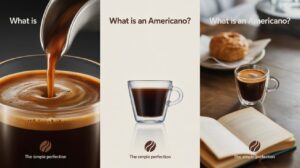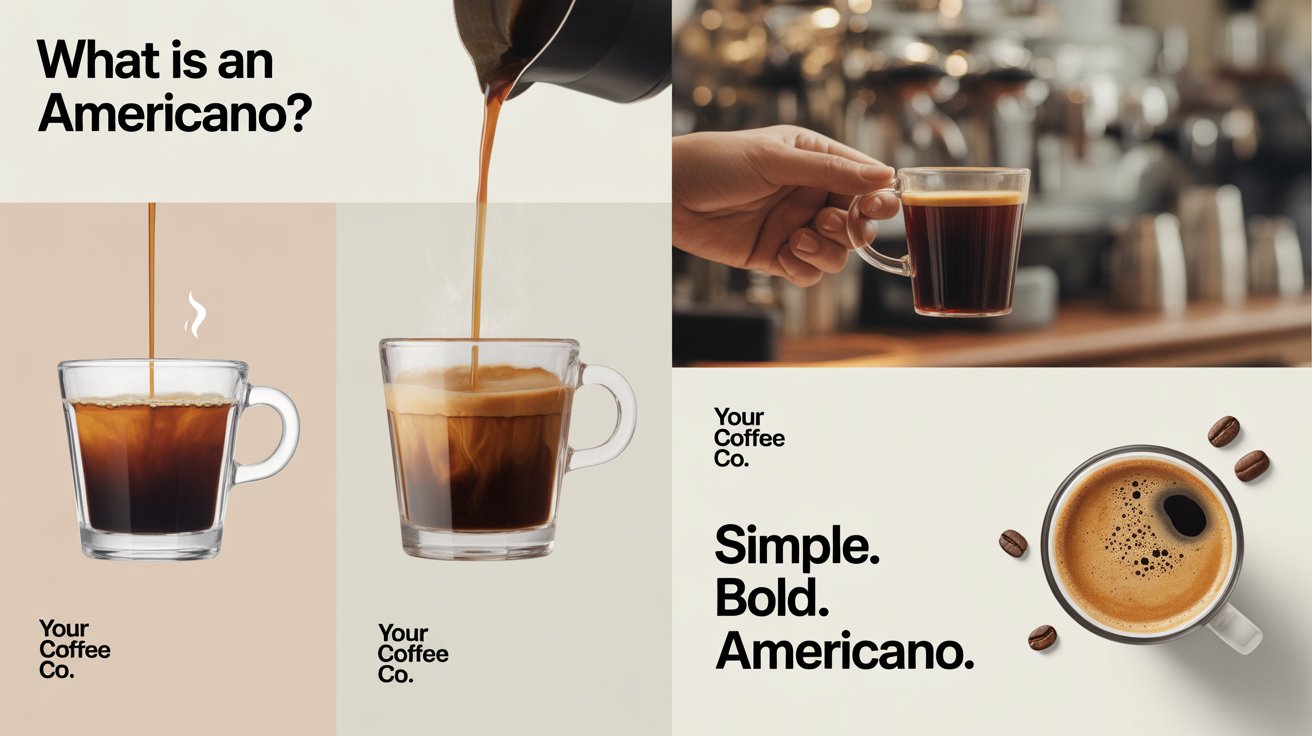Last updated on September 14th, 2025 at 01:17 am
What is an Americano? It’s simply espresso diluted with hot water — a bold yet smooth coffee that bridges the gap between strong espresso and drip coffee.
If you’ve ever found straight espresso too intense but black coffee too mild, the Americano hits that sweet spot. It delivers the same rich espresso flavor, but in a lighter, more sippable form.
Born during World War II when American soldiers in Italy watered down local espresso, this drink carries history in every cup. Today, it’s a café staple worldwide — served hot, iced, with milk, or even flavored with syrups.
In this guide, I’ll break down how it’s made, why it tastes so different from drip coffee, and the variations worth trying. By the end, you’ll know exactly why the Americano remains one of the most versatile espresso-based drinks ever created.
What is an Americano?
An Americano (or Caffè Americano) is espresso diluted with hot water. That’s it — just two ingredients, yet the result is a coffee drink that feels familiar to drip coffee lovers while staying rooted in espresso tradition.
How It Differs From Other Black Coffees
Here’s where most people get confused. An Americano isn’t the same as black coffee, even though they look identical in the cup.
Drip coffee is brewed by pouring hot water over ground beans (think pour-over or a standard coffee maker). The flavor is lighter, with more acidity.
Cold brew is steeped in cold water for hours. It’s smooth, low in acidity, and often stronger in caffeine.
Americano is made by adding hot water to one or two shots of espresso. The body is richer, the aroma more intense, and the mouthfeel closer to espresso than drip coffee.
If you want the strength of espresso without the small serving size, the Americano is your go-to.
More Than Just “Diluted Espresso”
While its core definition is simple, an Americano is recognized as a:
Coffee beverage — served hot in cafés and coffeehouses worldwide.
Caffeinated drink — typically containing 60–120 mg of caffeine per serving, depending on whether you use a single or double shot.
Hot beverage — traditionally enjoyed warm, though iced versions are increasingly popular.
What makes it unique is how it balances intensity with drinkability. You still get that espresso crema on top, but stretched into a smoother, more approachable cup.
In short, the Americano gives you espresso character in a larger, more versatile format. That’s why it’s not only a café menu staple but also a favorite among home brewers using everything from an espresso machine to a Moka pot.
Ingredients & Preparation

At its core, making an Americano is simple: espresso plus water. But the way you choose your ingredients and tools can make the difference between a flat, watery cup and a rich, café-quality drink.
Core Ingredients
Espresso – This is the backbone of the Americano. A single or double shot, extracted properly, gives you that concentrated flavor and crema. If the espresso is weak, the Americano will taste thin.
Hot water – The “diluter.” Adding hot water opens up the espresso, stretching its flavor without stripping away its character. Standard ratio: 1 part espresso to 2 parts hot water.
Cold water + ice cubes – For an Iced Americano, you swap the hot water for cold, pour the espresso over ice, and get a refreshing version perfect for summer.
Pro tip: Always use filtered water. Bad water quality kills flavor faster than bad beans.
Tools & Equipment
You don’t need a high-end café setup to nail an Americano. Here are your options:
Espresso machine – The gold standard. Consistent pressure, full crema, and control over extraction.
Moka Pot – An Italian stovetop classic. It produces a strong, espresso-like coffee that works beautifully when topped with hot water.
French Press – Not true espresso, but with a finer grind and a shorter brew time, it can mimic the intensity well enough for a “press-style” Americano.
AeroPress – Loved by home brewers. With the right recipe (fine grind + short press), it delivers a concentrated shot that rivals machine espresso.
Coffee grinder + coffee beans – Always grind fresh. Aim for a fine grind when using an espresso machine or AeroPress, and slightly coarser for a Moka Pot or French Press.
Gooseneck kettle – Essential for precision pouring, especially if you’re making Americanos with manual brewing methods.
First-hand tip: I’ve found that lighter roasts bring out fruity notes in Americanos, while darker roasts create a bolder, smokier cup. Experiment with both.
Optional Additions
While purists keep it simple, cafés (and home baristas) love customizing:
Milk alternatives – Almond, oat, or soy milk soften the edges and add creaminess without overpowering the espresso.
Sweeteners – Sugar, honey, or flavored syrups (vanilla, caramel, hazelnut) can turn a plain Americano into a café-style treat.
Bonus idea: Try an Americano with oat milk and honey — it’s smoother than a latte but still has that bold espresso backbone.
Brewing Techniques & Methods

Making an Americano isn’t just about pouring water into espresso. The order, the shot size, and even the brewing approach change how it tastes.
Traditional Methods
Hot Water First vs. Espresso First
The order of operations matters. If you pour espresso into hot water, the crema spreads across the top, giving the cup a smoother mouthfeel. If you pour hot water into espresso, the crema thins out but the flavor stays more concentrated. Try both — you’ll taste the difference.
Single, Double, Triple Shots
Single shot – lighter body, around 30 ml espresso.
Double shot – the café standard (60 ml). Balanced, bold, and still smooth when diluted.
Triple shot – for serious caffeine seekers. Intense, bitter, and best with extra water.
Pro tip: Most baristas recommend starting with a double shot for the “classic” Americano balance.
Alternative Styles
Lungo – A longer espresso pull that uses more water during extraction. Results in a milder, less intense Americano-like drink.
Caffè Crema – A Northern Italian specialty, brewed like a lungo but with coarser grounds. The body is thinner, closer to drip coffee.
Pour-Over Americano Style – Brew a strong pour-over and dilute it slightly. Not true espresso, but a great workaround if you don’t have a machine.
Manual brewing + pressurized extraction – Tools like the AeroPress, Moka Pot, or even a manual lever espresso machine can produce concentrated shots that form the base of an Americano.
Variants & Related Drinks
The Americano is endlessly customizable. Small tweaks transform it into entirely new drinks.
Americano Variants
Iced Americano – Espresso poured over ice and topped with cold water. Crisp, refreshing, and a summer café favorite.
White Americano – A splash of milk or milk alternative (like oat or almond) softens the espresso bite.
Americano with Syrup – Vanilla, caramel, or hazelnut syrups turn it into a flavored specialty drink.
Americano with Milk – Similar to a café au lait but with an espresso backbone instead of drip coffee.
Related Espresso-Based Drinks
Long Black
Popular in Australia and New Zealand, the Long Black flips the Americano method: hot water first, then espresso. This preserves more crema and gives the drink a stronger, punchier profile.
Red Eye
Espresso added to drip coffee. Twice the caffeine hit, and a favorite for late-night workers and students.
How It Compares to Other Espresso Drinks
Flat White – Espresso with velvety microfoam milk. Creamier than a White Americano.
Cappuccino – Equal parts espresso, steamed milk, and foam. Sweeter, lighter mouthfeel.
Latte – Espresso with lots of steamed milk, topped with a touch of foam. Smooth and milky.
Macchiato – Espresso “stained” with just a dollop of foam. Bold, small, and intense.
Mocha – Espresso, steamed milk, and chocolate. Dessert in a cup.
Cultural & Historical Context

Origins
The Americano has a wartime backstory. During World War II, American soldiers stationed in Italy found the local espresso far too strong. To make it more like the drip coffee they were used to back home, they began diluting shots of espresso with hot water. The result: the drink Italians jokingly called Caffè Americano.
This wasn’t just improvisation. It was the blending of two traditions — the Italian espresso culture, which values short, intense shots, and the American coffee culture, which prefers larger, longer sips.
Modern Coffeehouse Culture
Fast-forward to today, and the Americano has cemented its place on menus from Starbucks to independent coffeehouse establishments in Rome, Melbourne, or New York.
On a coffeehouse menu, it usually sits alongside espresso, cappuccino, and latte as the “straightforward black coffee option.”
In terms of coffeehouse etiquette, it’s the go-to for customers who want something bolder than drip coffee but not as heavy as a latte.
It shapes coffeehouse ambience because it appeals to both purists (who want espresso character) and casual drinkers (who want a longer, less intense cup).
Observation: In many third-wave cafés, ordering an Americano signals you value espresso but also enjoy savoring coffee slowly — almost like a cultural bridge between espresso shots and filter coffee mugs.
Nutritional & Sensory Information
Caffeine Content
An Americano’s caffeine depends on the espresso shots used:
Single shot: ~60–70 mg caffeine.
Double shot: ~120–140 mg.
Triple shot: ~180–210 mg.
That’s less caffeine than a 12 oz drip coffee (~150–200 mg) or a 16 oz cold brew (~200–300 mg), but the flavor intensity makes it feel stronger.
Caloric Content
On its own, a black Americano is virtually calorie-free (around 5 calories). Add-ons change the math:
With a splash of oat or almond milk: +20–40 calories.
With flavored syrups: +50–100 calories, depending on pumps.
Sensory Notes
What does an Americano actually taste like? Think of it as espresso’s flavor stretched into a longer format:
Acidity level: Balanced. Softer than espresso, sharper than drip coffee.
Bitterness: Noticeable, especially with darker roasts.
Flavor profile: Depends on beans — fruity with light roasts, chocolatey with dark.
Aroma: Stronger than drip coffee thanks to espresso extraction.
Body: Medium, less syrupy than straight espresso but fuller than pour-over.
Crema: Present if water is added after the espresso. Dissipates if done the other way around.
Mouthfeel: Smooth, warming, and less heavy than milk-based drinks.
Tip from experience: If you want more complexity, start with a double-shot Americano made from freshly ground beans. It balances caffeine kick, crema, and mouthfeel perfectly.
Americano vs Other Coffee Drinks
The Americano often gets mistaken for other black coffee styles. But each drink has its own brewing method and taste profile. Here’s how they stack up.
Americano vs Black Coffee
Brewing method: An Americano is espresso plus hot water. Black coffee is drip, pour-over, or French press brewed directly from ground beans.
Taste: The Americano has a richer aroma and a layer of crema. Black coffee is lighter, often more acidic, and less intense.
Americano vs Drip Coffee
Brewing method: Drip coffee uses gravity and a paper filter. An Americano uses pressure-extracted espresso.
Taste: Drip coffee feels “cleaner” with a smooth body. Americano carries espresso’s boldness and mouthfeel, even when diluted.
Americano vs Cold Brew
Brewing method: Cold brew steeps coffee grounds in cold water for 12–24 hours. Americano is instant — hot water added to espresso.
Taste: Cold brew is smooth, chocolaty, and naturally sweet. Americano is sharper, warmer, and has a more dynamic flavor profile.
Caffeine: Cold brew often has more caffeine per ounce, but a triple-shot Americano comes close.
Americano vs Café au Lait
Brewing method: Café au lait uses brewed coffee (often drip) with hot milk. Americano is espresso with water, sometimes with a splash of milk.
Taste: Café au lait is creamy, mellow, and milk-forward. Americano with milk still keeps espresso at the center.
Pro tip: If you want crema and intensity, go Americano. If you prefer mellow comfort, café au lait is your friend.
Popularity & Coffee Culture
The Americano has moved far beyond its wartime origins. Today, it’s a staple in both coffee preparation and coffee brewing worldwide.
In the U.S., it’s the “bridge drink” for drip coffee fans curious about espresso.
In Europe, it blends seamlessly into Italian espresso culture and coffeehouse menus.
In Asia, especially South Korea and Japan, the Iced Americano has become a year-round favorite.
Its popularity stems from versatility. You can drink it black, iced, flavored, or with a splash of milk. And because it scales easily — single shot, double, triple — it works for both light sippers and heavy caffeine drinkers.
Beyond the cup, the Americano shapes coffeehouse ambience. Ordering one says you appreciate espresso but want something you can sip slowly, maybe while working, reading, or chatting. It’s not just a drink; it’s a cultural marker of modern coffee consumption and coffee culture.
How to Make the Perfect Americano at Home
You don’t need a barista’s badge or a $10,000 La Marzocco to brew a proper Americano. With the right beans, water, and a little technique, you can master it in your own kitchen.
Step-by-Step Recipe
Pull the espresso. Start with 1–2 shots (about 30–60 ml) of freshly brewed espresso using an espresso machine or a moka pot.
Heat the water. Use filtered water between 160–170°F (70–77°C). Avoid boiling water, which scorches flavor.
Combine. Add 3–4 oz (90–120 ml) of hot water to your espresso. For a stronger cup, go 1:2 espresso-to-water. For a lighter taste, stretch it to 1:3.
Serve immediately. A true Americano should have a warm body, light crema, and a balanced aroma.
Pro Tips from Coffee Pros
Beans: Medium or medium-dark roasts work best. Think single-origin Colombian or a balanced Italian espresso blend.
Grind size: Use a fine grind, slightly coarser than Turkish but finer than drip. Consistency matters for even extraction.
Water quality: Use filtered water. Minerals influence flavor more than most home brewers realize.
Order matters: Pouring water over espresso creates a softer crema. Adding espresso to water preserves more crema. Experiment to find your preference.
Customization Ideas
Milk alternatives: Oat milk adds creaminess without overpowering. Almond milk brings nuttiness. Soy milk balances acidity.
Syrups: Vanilla, caramel, or hazelnut syrups transform the Americano into a café-style drink.
Iced version: Brew espresso, pour over chilled water and ice. It’s the drink of choice in Seoul’s coffee shops year-round.
Conclusion
The Americano is more than “espresso with water.” It’s a drink with roots in World War II history, anchored in Italian espresso culture, and loved by modern coffeehouses worldwide.
Its charm lies in versatility. You can enjoy it hot, iced, bold, or mellow. It adapts to your mood — whether you sip it black, swirl in oat milk, or sweeten it with a touch of vanilla.
If you’ve never made one at home, start today. Experiment with ratios, play with different beans, and discover your perfect version. And when you’re ready to branch out, try exploring other espresso-based classics like the long black, flat white, or café au lait.
At the end of the day, the Americano is proof that simple doesn’t mean boring — it means timeless.
FAQ
What is an Americano?
An Americano is a coffee drink made by adding hot water to one or two shots of espresso. This process dilutes the espresso, resulting in a beverage similar in strength to drip coffee but with a distinct flavor profile.
How is an Americano different from drip coffee?
While both are similar in strength, an Americano starts with espresso, offering a richer and more aromatic taste compared to drip coffee, which is brewed differently.
Why is it called an Americano?
The name “Americano” is believed to have originated during World War II when American soldiers in Italy diluted espresso with hot water to mimic the coffee they were accustomed to back home Wikipedia.
How do you make an Americano at home?
To make an Americano, brew one or two shots of espresso and add hot water. The typical ratio is about 1/3 espresso to 2/3 hot water, but this can be adjusted to taste Nescafe Australia.
Can you make an Americano without an espresso machine?
Yes, you can use a strong brewed coffee as a substitute for espresso. Brew a concentrated coffee and add hot water to achieve a similar taste to an Americano SpotOn.
What does an Americano taste like?
An Americano has a smooth, bold flavor with a slightly bitter edge, offering a more robust taste than regular black coffee due to its espresso base.
Is an Americano stronger than a latte?
Yes, an Americano is stronger than a latte because it contains more espresso and less milk, resulting in a more intense coffee flavor.
What’s the difference between an Americano and a long black?
The primary difference lies in the preparation method. In an Americano, hot water is added to espresso, whereas in a long black, espresso is poured over hot water, preserving the crema and resulting in a different flavor profile Coffee Bros.

Shahriar brings a unique blend of storytelling prowess and digital expertise to Daily Coffee Guide. With a background in SEO and content strategy, he ensures our articles on Beans, Coffee, Tea, and Drinks are both engaging and discoverable. His passion for coffee culture drives him to explore and share the rich narratives behind every cup.

